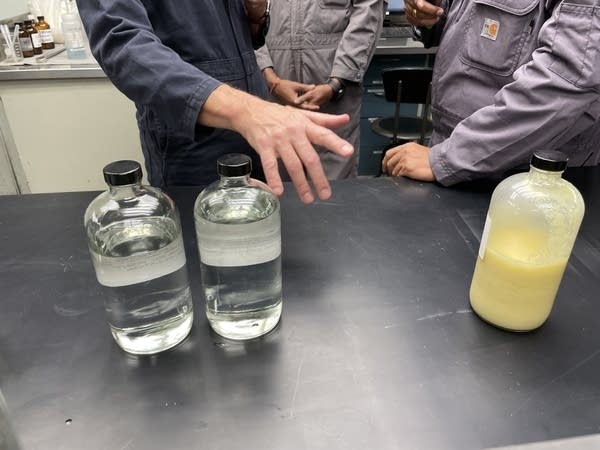The Biden administration’s bet on sustainable aviation fuel

Congress has authorized trillions of dollars in new spending through the Inflation Reduction Act, CHIPS and Science Act, and the Bipartisan Infrastructure Law. In a new series called “Breaking Ground,” “Marketplace” host Kai Ryssdal will be visiting communities across the country to look at how this infusion of federal dollars might change the economy — in complicated, invisible, even contradictory ways.
In this episode, Ryssdal explores one industry that’s getting a push from the Inflation Reduction Act: sustainable aviation fuel.
Click the audio player above to hear the story.
What is sustainable aviation fuel?
Sustainable aviation fuel (SAF) is an alternative to conventional petroleum jet fuel. SAF can go into regular airplanes but is made with synthetic or renewable sources, like vegetable oil or animal fat.
Unlike the automotive industry, where electric vehicles rival their gas-powered competitors, aviation is considered a “hard to decarbonize sector” said Candelaria Bergero, a researcher and Ph.D. candidate in earth system science at the University of California, Irvine. There are no electric or hydrogen-powered airplanes on the market that can replace the long-haul passenger jets flying today.

With roughly 100,000 airline flights every single day, aviation contributes more than 2% of global carbon dioxide emissions.
“I think we all benefit from flying,” Bergero said. “So if we could find a way to do this without harming the planet, I think it’d be very beneficial.”
Bergero and her colleagues analyzed potential scenarios in which the aviation industry could reduce emissions through increases in efficiency, decreases in demand and increased use of SAF.
“We found that even though there are several ways you could achieve a net-zero aviation system, the idea of deploying sustainable aviation fuels in large scales would be very important.”
The federal government’s role in deploying SAF
Though the U.S. produced less than 16 million gallons of SAF in 2022, the Biden administration has set a target of making that 3 billion gallons by 2030 and 35 billion gallons by 2050. It’s a cornerstone of the administration’s strategy for reducing the climate impact of aviation.

To help make that happen, the Inflation Reduction Act of 2022 created a new, per-gallon tax credit aimed at reducing the cost of SAF. There is also a new grant program, funded by the IRA, aimed at incentivizing SAF production.
“The government is critical,” said Gene Gebolys, founder and CEO of World Energy, one of the biggest SAF suppliers in the country. “It’s neither just the government or just the private sector, it’s the government and private sector working in concert that is going to enable us to decarbonize aviation.”
Staying grounded: exploring the limits of SAF
At this point, SAF accounts for less than 1% of global jet fuel demand.
“So firstly, we need to concentrate on increasing the production capability,” said Bhupendra Khandelwal, an associate professor of mechanical engineering at the University of Alabama who studies alternative fuels. “Each plant costs upwards of $300, $400, $500 million [to build], trained workforce and all the materials, [so] it’s not going to happen overnight,” he said.

Also, not all SAF is created equal. “When we say ‘sustainable aviation fuels,’ we kind of imply that they’re all the same, but they’re not,” Bergero said. For example, if the energy powering a biofuels production plant comes from fossil fuels, that can cancel out carbon savings.
Producing enough feedstock, or source material, to significantly increase SAF production could increase competition for land. “If you’re deforesting a very pristine place to create your feedstock for aviation, sure, aviation will get all the gold medals for being net-zero,” Bergero said, “but then in the atmosphere, you will be releasing all of this carbon [by] deforesting this pristine forest.”
The key, Bergero said, is understanding the “holistic” cost of any new project. “You want to be very careful that you’re not creating other problems by making aviation net-zero,” she said.













